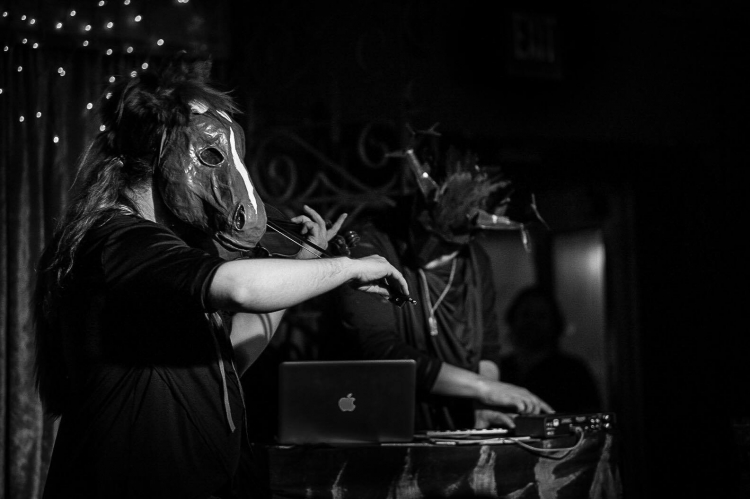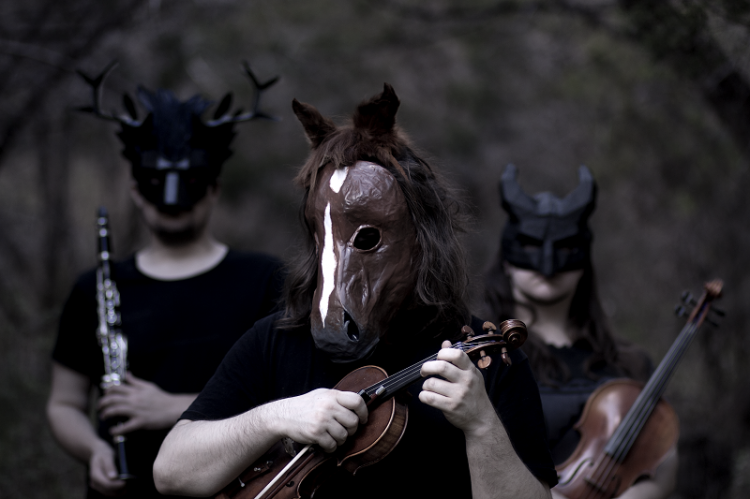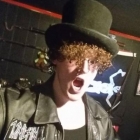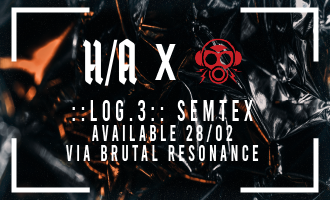Nokken and the Grim is a new neofolk band - but to put them under one genre would be considered a grave sin. Soaked in mythological elements and Pagan backgrounds, each member of Nokken and the Grim brings their own unique flair to the end product. Each having their repertoire in different genres - from metal to ambient to folk to blues (of all things), this trio is getting ready to put out their album "Treason to Our Nature". With that being said, we at Brutal Resonance sat down with all three of the band members for an in depth look at their album. Not only that, but we are also proud to premiere their new album which can be streamed directly below with the push of the play button. Read on while you enjoy these primal sounds:
Nøkken + The Grim is new to Brutal Resonance, so I'd like to start off with introductions. I understand there are three of you in the band, Justin Gortva Scheibel or Nøkken, Stephen Ian Savage or Peryton, and Karoline Leal or Ajatar. What are each of your roles in the band and what instrument do you play?
Justin: I'm the lead violinist for the group. On stage, I pull a lot of riffs and improv, trading off solos with Stephen and Karli. But behind-the-scenes, I do the managing and produce a lot of the ideas and story that knits our group together.
Karoline: I play the viola, and basically take charge of rhythm and pulse, like a rhythm guitar. That’s actually kind of what the viola does in the classical world…but then I also originally wanted to be a bassist. So, I guess now I kind of do both?
Stephen: I play clarinet and synths/keyboard. I usually do a lot of behind-the-scenes work to produce the electronics that we play with. In my daily life, I'm a composer and clarinetist, so this is the perfect melding of my two main jams.
Let's talk of origins now. The project started in 2015. Whose idea was it to create Nøkken + The Grim and where did you all meet? Did you guys work well together at first or was it rough getting the project off the ground?
Justin: It originally was a solo project. I adopted the name Nøkken from the Norwegian myth of a shapeshifting water-horse spirit who played violin. I started wearing a plastic horse mask on stage, and it quickly became my alter-ego. I was thinking that this old, dark creature had stepped out of the cracks of time, brought about by the strife and struggle of people to find meaning and spirituality in this day and age. It evolved organically from there when I asked Stephen and Karli to play. They adopted personas too. To me, it was as if, now that the doorway was open, other spirits were free to come through.
Karoline: We all went to music school together in Cincinnati around 2009, I was doing graduate school at the time. So, I guess we all have been working together for quite a while… we all played in ensembles with each other back then.
Stephen: It was difficult at first to even know how to combine our instruments and playing styles into a cohesive group. There was lots of discussions, differences of opinion, and frustrating moments. When we first started working on "Treason to Our Nature", Justin and I disagreed on what directions to take the sound, and ultimately that conflict allowed us to explore new, exciting territory.
Official recording for your debut album “Treason to Our Nature” began in 2017 and lasted through 2018. Is this the first piece of music that has been put out by you, or are there other possibly demo pieces roaming the internet somewhere?
Justin: As a group this is the first major release we’ve had. Each of us has collaborated on different projects in the past, but mostly local stuff to Austin. There are some improvised works floating around on our YouTube and Soundcloud pages, and I’ve done this crazy-ass violin piece Stephen wrote called “Overhead Freeway” which is available as a single on our Bandcamp.
Stephen: Yeah, I'm sooooo sorry for how hard that piece is to play, but you did ask for a crazy, ridiculously amazing solo piece, so what could I do!?
I understand that “Treason to Our Nature” was recorded with both live improvisation as well as studio recordings. I imagine that there is some difficulty in shuffling live recordings with studio sessions. How did you manage to pull that off?
Stephen: It was tricky for sure…when we play live, we play with prerecorded electronics on some songs. For those, we isolated our acoustic sound and then re-incorporated it into more studio electronics, then edited it, mixed it and so on. Others songs are completely improvised, so those were much easier, just simple mixing.
Justin: The hardest thing was balance and blending so that the the live and studio elements didn't feel out of place. We also have a fantastic audio engineer here in Austin, Evan Kleinecke of 5th Street Studios, who did the mastering. He's a sonic magician!
There is a wide range of influences on this record from metal, folk, blues, neo-classical, as well as your stunning depictions of the already mentioned Norse and Magyar folklore. How do you blend all these elements together?
Karoline: I mean, I honestly didn’t grow up listening to classical, I was basically raised on metal and folk music by my parents. I also like to force other people to listen to my music, so it kind of follows that it would leak into whatever we’re doing…we all listen to a wide variety of music and come from a variety of musical backgrounds. For me at least, it’s not necessarily a conscious decision.
Stephen: For me it was just fun to smash genres up and see what happens. Especially on "Blue Ritual," I started with an electro/rock beat and added funky Jazz chords and scales just to see what kind of sounds and affects we could get out of it.
Justin: It’s all about seeing music from this primal, animal mindset. I try to experience and play without imposing my own preconceptions. After all, we play creatures that are very nonhuman, so they wouldn’t care for or even maybe understand how human music and genres work. To them, music might be another thing entirely. For me personally, I enter into a sort of deep trance where I feel not human when I am performing on stage.

From reading the description of the album, it seems to be a bit of a concept album as – very well put by yourselves – a war between Mother Nature and industrialized civilization is going on. What exactly is the entirety of this story and how does it reflect contemporary times?
Justin: The story spans the recorded history of humans. At the beginning, people occupy this animistic world of nature and spirits. But as time progresses, humans start to move away from that and seek to control their environment. They hunt and kill the spirits of the old world, especially in “Be Forsaken, Shapechanger,” which was inspired by historic executions of witches, shaman and individuals who practiced shapeshifting rituals in Europe. But gradually humanity’s machinations start to gain a life of their own, consuming living things. Even the very ground becomes synthetic. Some humans and spirits of the old world rise up with Mother Nature against the machines, while other humans seek to become cyborgs and choose to integrate themselves with synthetics. All-out war breaks out at the end, resulting in a cataclysmic event. After that? Who knows? What survives?
I feel that we are all at a major crossroads in which there are competing ideas of posthumanism struggling against each other. There is a lot of movement now to recognize human beings as kin with other life, to recognize that we are animals and share this world with others. Some people realize this through spiritual means in reviving old ‘Pagan,’ native and shamanistic beliefs. Others see it as a secular moral imperative. At the same time, there are people who desire to transcend their own bodies, who embrace technology and look down at nature and animals only as something to leave behind or use as a resource. A lot of forces in the economy are completely apathetic towards other-than-human life. Technology is accelerating, and we are leaving a wake of environmental devastation and extinctions in our paths. I don’t really see the story as something fictional, but rather a way of looking at the history of Western civilization.
Stephen & Karoline: What he said.
Each of your names - Nøkken, Peryton, and Ajatar – are one of three nature spirits that appear during this conflict. Can you tell us the back stories of each of these spirits and what they do within “Treason to Our Nature”?
Justin: Nøkken is a shapeshifter who was feared in Norwegian folklore. He was known to lure human beings to drown in the river either as a musician or as a horse. As human technology starts to consume the land, however, he becomes sympathetic and tries to gather other spirits to stop it. This culminates in initiating a ritual which fails. A human hunter who fears and loathes the creatures attacks and interrupts the ritual.
Stephen: I'm Peryton, and I used to be the White Stag of Hungarian myth. Pollution turned my white fur black, which left me angry and vengeful. I grew black feathers to fly above the ever-growing smog, but it always climbed higher. I decided to infiltrate human technology and sow seeds of discontent among its users. You can hear my frustrated cries within the synthesized electronic sounds we use.
Karoline: Ajatar is a Finnish myth, the mother of nature spirits. She kind of represents the spirit of the Earth herself as well as forbidden knowledge. She works from the background trying to nurture peace, but if you piss her off she can transform into a draconic type creature, hence the horns. So with what is going on in the world currently, you can imagine she's pretty pissed off.
I imagine that “Treason to Our Nature” is meant to be played all at once and forgoes the usual single treatment that most bands go for. That being said, which out of all the songs on the album are your favorites and why?
Stephen: Blue Ritual…I mean, that beat though.
Karoline: For me I’d say Lament on Synthetic Ground… I definitely wouldn’t say it could be called a single, but I just really enjoy that one.
Justin: I really like “Be Forsaken, Shapechanger.” Stephen ran his clarinet through the laptop at the show and produced this insane sound like a cross between a clarinet and a cyborg throat singer.
And what else do you all have planned for 2018? Do you have any shows, collaborations, or possibly any other singles planned?
Justin: Yeah, we have couple shows around Austin this month and an EP we’re putting the finishing touches on. We hope to release it in the next few months. For the rest of 2018, we're really focusing on producing a lot of music.
Stephen: We've already starting writing new material! Our natural state is experimentation, so we've been trying out a new songwriting process.
Lastly, I would like to thank you for your time. We wish you the best of luck and can't wait for the album to be released. Cheers!
Stephen: Thanks, this was fun!
Karoline: Thanks for talking with us!
Justin: It’s been awesome, dude!






